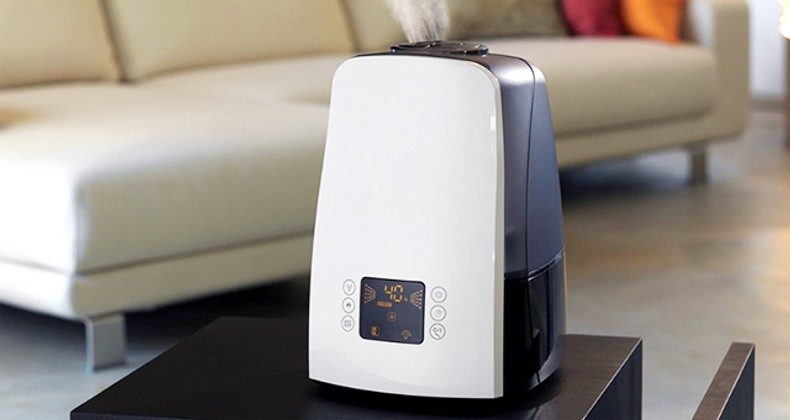Humidifier Frequently Asked Questions
Free Shipping Every Day
Standard shipping is free to the lower 48 states. We also offer 3-Day, 2-Day or Next-Day shipping for a variety of products.
Shipping to Hawaii, Alaska, and Canada may incur additional shipping charges.
Canadian shipments may incur duties, taxes and brokerage fees after your order is confirmed. These fees are non-refundable and will not be reflected in your order total.
For more information, go to Shipping & Delivery Information.
Ask Our Experts

When shopping for a humidifier, it's helpful to understand how it works, what type is best for you, and the expected maintenance required.
We address these topics and much more in our FAQs:
- How does a humidifier work?
- What is the ideal humidity level I should maintain?
- What size humidifier do I need?
- What does humidifier capacity mean?
- How do I add water to the humidifier?
- How often will I need to refill my humidifier?
- What can I use in my humidifier?
- How often should I use my humidifier?
- When should you not use a humidifier?
- Where should you not put a humidifier?
- How far away should you be from a humidifier?
- How do I clean my humidifier?
- What is the best humidifier for a bedroom?
- Is it safe to leave a humidifier on overnight?
- Where should a whole-house humidifier be placed?
How does a humidifier work?
Humidifiers increase the humidity of a space by adding moisture to your indoor air. There are a few different methods for this process:
- Evaporative humidifiers speed up the natural process of evaporating water into the air using internal wicking media that absorbs water and then adds it to dry air pushed through by a fan. The newly moistened water flows into the air.
- Ultrasonic humidifiers use ultrasonic sound frequencies to vibrate a metal or ceramic disc until it reaches high-speed movement, creating microscopic water droplets that fans release into the air as an invisible mist.
- Steam humidifiers, also known as warm mist humidifiers, boil water as part of the humidifying process before releasing an ultra-fine warm mist into your indoor air.
If you’re looking for an air purifier and humidifier combination, check out our hybrid products or learn more about air washers to see if they’re a viable option.
Check out our Cool Mist vs Warm Mist Humidifiers comparison guide for more information.
What is the ideal humidity level I should maintain?
According to the United States Environmental Protection Agency, the ideal relative humidity level is between 30 and 50 percent. Humidity above 60 percent creates a breeding ground for mold, dust mites, bacteria, and other pests. If the humidity is below 30 percent, the likelihood of cold and flu viruses spreading and possible uncomfortable respiratory symptoms increases.
Read our article Understanding Relative Humidity for more information on relative humidity and your health.
What size humidifier do I need?
Sizing a humidifier depends mainly on the square footage of the area you want to humidify. Most humidifier manufacturers provide a square foot coverage range as part of their product's specifications. A standalone room humidifier can generally cover a bathroom, bedroom, office, living room, and more by itself, depending on the square footage specified for the model.
Remember that console and ducted whole-house humidifiers will cover large areas and, sometimes, your entire house.
What does humidifier capacity mean?
Humidifier capacity refers to a humidifier's maximum moisture output per 24 hours. Capacity differs from a humidifier's water tank or reservoir size, which refers to how much water the reservoir can hold when filled.
How do I add water to the humidifier?
Portable tabletop and console humidifiers feature one or more water reservoirs. To fill your humidifier, open the reservoir and pour in clean water. Some humidifiers will be small enough to carry to a sink for filling, while others may feature top-fill reservoirs that make it easy to fill with a pitcher or hose.
Ducted, whole-house humidifiers do not have water reservoirs. Instead, they hook up directly to your home's water supply to draw water as needed.
How often will I need to refill my humidifier?
Most portable humidifiers need a refill once every 24 hours if you plan to use them continuously throughout the day and night. Some models provide continuous humidification for more than 24 hours per refill. If you use your humidifier intermittently, you will refill it less often.
How often should I change my humidifier water?
Change the water in your humidifier daily. If you don’t use it daily, don’t keep water in the tank or reservoir – only add water when you use it. Should there be any leftover water after running the humidifier overnight, empty that out and add fresh water instead.
What can I use in my humidifier?
Can I use tap water to fill my humidifier?
Yes, you can use tap water in your humidifier. However, since tap water can contain an overabundance of minerals and microbes, leading to bacteria growth inside the machine, consider using distilled or demineralized water instead.
Can I use hard water to fill my humidifier?
Yes, but remember that hard water contains elevated mineral content that, when released into your air, may solidify as an unhealthy irritant known as white dust. Breathing in white dust over prolonged periods may aggravate existing respiratory issues or cause new problems to develop. Mineral cartridges absorb most minerals from hard water, making them less likely to be released into your air.
If your humidifier does not have a mineral cartridge, we recommend filling your humidifier with distilled water, which is free of minerals.
Can I use anything other than water in my humidifier?
Since the purpose of a humidifier is to add moisture to the air, water is the best thing you can put in the humidifier.
Can I use essential oils in a humidifier?
If you want to deodorize while humidifying, consider selecting an aroma diffuser. Adding a few drops of essential oil to the water reservoir can refresh a stale room. For other humidifier types, you'll want to refer to your owner's manual to determine whether it can accommodate essential oils.
How often should I use my humidifier?
How often you use a humidifier depends on your climate and how it affects your indoor air. If you live in a typically dry environment, like the US Southwest, you may need to use your humidifier more often to maintain a comfortable humidity level in your home.
If you live in a high-humidity area, such as the US Southeast, you may only need to use a humidifier during the coldest months when your heating system runs most of the time since this creates drier air.
No matter where you live, you'll also want your humidifier handy when you have the flu or a cold and need extra humidity to help alleviate symptoms. Any time your home's air leaves you with itchy skin or painfully dry nasal passages, you can use your humidifier to add comforting moisture.
When should you not use a humidifier?
If you live in a high-humidity environment, running a humidifier will increase the relative humidity to above 60 percent and can result in mold, bacteria, dust mites, and more. A humidifier may hurt more than help if not thoroughly cleaned and disinfected often, especially if you have allergies or asthma.
Where should you not put a humidifier?
Standalone humidifiers should be placed on an elevated surface, away from the floor or carpet, and out of reach of small children and pets. Position them away from electrical sockets, wires, and electronics like computers and gaming systems.
For larger areas, console humidifiers typically include a recommended clearance from walls so the drywall does not immediately absorb the released moisture and cause mold and mildew growth.
How far away should you be from a humidifier?
We recommend placing the humidifier three feet away to avoid accidental spills, whether sitting or sleeping. Place the humidifier at least three to four feet away from a baby’s crib.
How do I clean my humidifier?
It's essential to clean your humidifier regularly to avoid the risk of bacteria growth, such as mold and mildew, which can be released into your air when the humidifier is running. We recommend thoroughly cleaning and disinfecting your humidifier every three days. Some manufacturers recommend a weekly cleaning, so check your owner’s manual for additional maintenance steps and tips for your model.
Read our blog post on humidifier maintenance for more information.
What is the best humidifier for a bedroom?
Ultrasonic humidifiers are ideal for bedrooms and nurseries because they are some of the quietest humidifiers available. Since there’s no fan inside, the noise level is minimal. For example, the SPT Ultrasonic Dual Mist Humidifier has a noise level of about 32 decibels, the same level as a whisper.
Steam humidifiers are also a quiet solution, as the heating element boils the water to release steam vapor without a fan. The Boneco S200 Steam Humidifier runs at less than 35 decibels for whisper-quiet operation.
Is it safe to leave a humidifier on overnight?
Yes, leaving a humidifier running all night is perfectly safe. Once morning comes, it’s important to dump out any leftover water and be sure the unit is cleaned, dried, and ready to go again the next night.
Where should a whole-house humidifier be placed?
Whole-house humidifiers are ducted units, so they are installed on either the vertical or horizontal warm air supply or the cold air return plenum of your furnace system. Consult your owner’s manual for more information concerning installation.
Take a look at our Whole-House Furnace Humidifier Buying Guide for additional information.
In Summary
At the end of the day, whether cool mist or warm mist, ultrasonic or an air washer, all humidifiers work to accomplish one goal: leaving you more comfortable and healthy by adding moisture to your air.
Still Have Questions?
Ready to shop? Browse our humidifiers and find the suitable model for you. You can also return to our Humidifier Knowledge Center and learn about these must-have wintertime solutions. Be sure to take a look at our top tabletop humidifiers.
Not sure what's best for you? We can take the guesswork out of decision-making. Contact our air treatment experts toll-free at 1-800-934-9194 for a free consultation and product recommendation. We want to help make your indoor environment a healthy one.
Ask Our Experts































